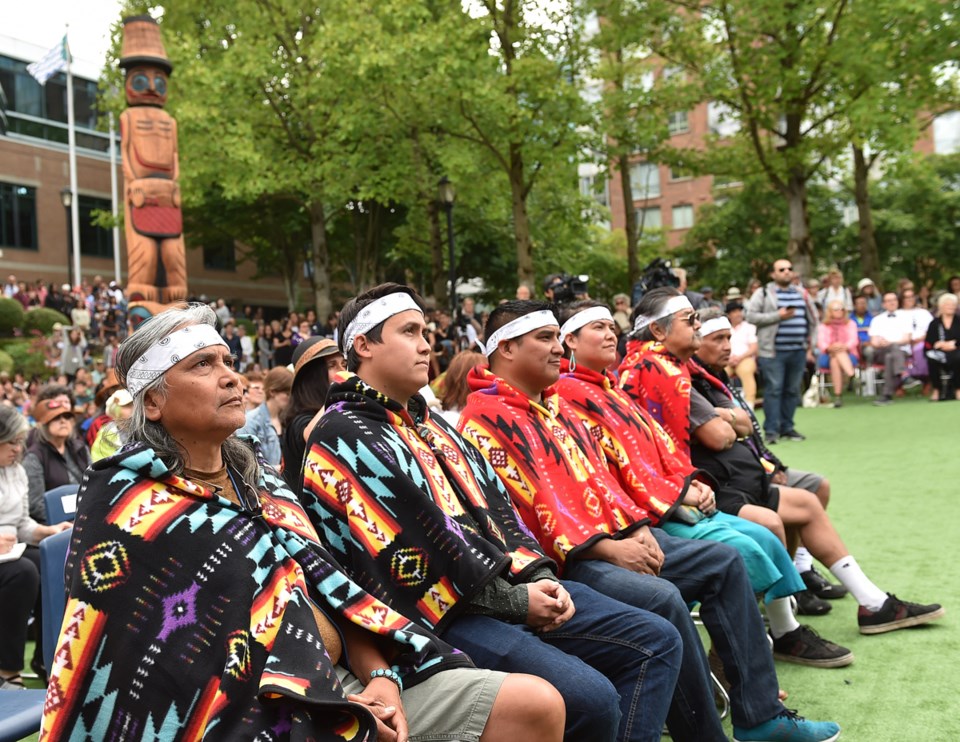What does reconciliation mean?
“Peace, happiness, hope.”
“Coming together, try better.”
“Imagination, truth, respect, relationship, love.”
Those are the some of the words chosen by students, who decorated cedar shavings, shaped like feathers with their ideas of reconciliation.
The cedar shavings came from , unveiled at the Â鶹´«Ă˝Ół»School Board’s West Broadway office on Friday — National Indigenous Peoples’ Day — in a ceremony live-streamed to the entire district.
Carver William Dan, who carved the male welcome figure, was asked what reconciliation means to him. When he answered, he spoke of being a young boy sent to residential school. Today, nearly 70 years old, he says all he wanted to do was go home to his parents.
“It’s hard for us to get over that. They really beat you to the floor,” Dan said. “But you’ve got to let it out. You’ve got to lighten your heart.”
Dan’s male welcome figure is matched with a female welcome figure, with a 44-foot reconciliation pole towering behind them.
Carved from 300 to 500-year-old cedar logs, the hope is that these poles will stand 150 years or more, said Chas Desjarlais, VSB’s district vice-principal of Indigenous education, who along with Davita Marsden, Indigenous education teacher, spearheaded the project.
“It is a dream come true,” said Desjarlais, who is Nehiyaw-Metis and a member of the Cold Lake First Nation. “We are in a time where people are trying to reconcile the dark history that Indigenous people have experienced. This is a moment of beauty.”
She said the poles are meant to lift up and heal all children around the world.
“We do it for our children who are here today and we have a responsibility for the next seven generations,” Desjarlais said. “We’re not going to see the long-term impact, we’re only going to see the impact within our lifetime. But our children and their children, they’re going to see the ripple effects.”
As the poles were unveiled in front of a crowd of hundreds of students and adults at the VSB offices, children drummed and sang and Indigenous dancers and storytellers performed to celebrate the poles.
“Only your actions can make change,” Desjarlais said. “Your words don’t.”
Chrystal and Chris Sparrow carved the female welcome post, which Chrystal said is designed to represent all women, as equals and friends. The female post, cedar with inlaid copper, includes a killer whale and a female figure.
“Reconciliation to me is healing,” Chris said. “The copper colour is to bring power.”
The male pole, richly coloured in blue and red, includes a male figure holding a salmon to feed people and a beaver, which builds homes and looks after families.
The centre piece is the reconciliation pole, carved by Xwalacktun and his son James Harry. The father carved the top, which includes a thunderbird and a frog, while the son carved the bottom, which includes a bear to represent strength, an eagle and a buffalo head to represent all First Nations people. Also in the middle is a woven section, which is meant to signify unity among people.
“We want to see that healing grow all around the world,” Xwalacktun said. “We all have to pull together and work together. … There is a lot of work to be done yet.”
The artists represent the Squamish, Musqueam and Tsleil-Waututh Nations.
VSB superintendent Suzanne Hoffman said the poles show the important role that Indigenous culture plays in the district.
She said she is hopeful the poles will serve as a reminder of the wrongs of the past, such as residential schools and the missing and murdered Indigenous women.
“I am hopeful we can help those people who have been harmed by those acts to heal,” Hoffman said. Ěý
Larry Grant, an elder from the Musqueam Nation, said he went to Strathcona elementary in the 1940s, when he said there was “complete denial” of Aboriginal history.
“We have a long, long way to go to move beyond that 1940s mind set,” Grant said. “Finally, the school district is giving recognition to Aboriginal people’s history.”
Even if there has been progress, there are still gaps for Indigenous students, B.C.’s auditor general Carol Bellringer said in a report released this week. She called it a “racism of low expectations,” in an earlier report.
Seventy per cent of Indigenous students now graduate, versus 86 per cent of non-Indigenous students, Bellringer found. Indigenous students are also more likely to feel bullied, teased or picked on, data from the Student Learning Survey shows.
Cali Pelletier, a Grade 7 student from Strathcona elementary school, said she doesn’t believe reconciliation is happening yet, because she still sees a lot of pain. She hopes it will happen one day, so that “we would live with pride without fear for our lives.”
Desjarlais, who was a social studies and drama teacher for 14 years at Gladstone secondary, said she agrees there is much more work to do.
Graduation rates for Indigenous students in Â鶹´«Ă˝Ół»have improved over the past five years, she said. Ěý
“We’re not satisfied with 56 per cent. We’re going to continue to push to make sure our students get to graduation, they graduate with dignity and purpose and that they can go on in life to do whatever they wish to do,” Desjarlais said. “I won’t rest until I see equity and parity in the Indigenous grad rate with the non-Indigenous grad rate.” Ěý
Although this is meant to be an opinion column, for today, I’m going to let the words of those involved speak for themselves.
Ěý
Ěý



